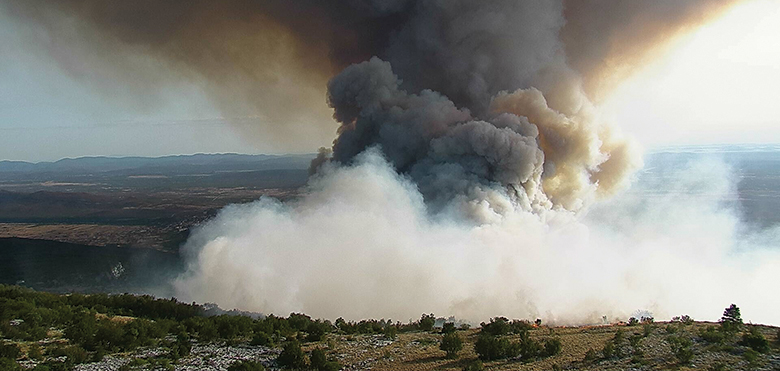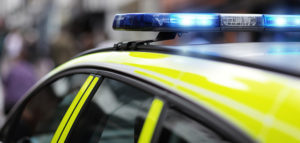Fighting fire with cameras – an innovative and logical step forward
Thousands of fires are recorded by fire and rescue services every year. These can have wide ranging causes, but the effect is always devastating if not immediately halted. Devastating wildfires such as the recent Maui Fires of August 2023 and the Australian bushfire season of 2019-20 –colloquially known as the Black Summer – are sobering examples, with many lives lost and millions of hectares of land destroyed.
The impact of fires is being increasingly felt across the globe. Recent data collected by the European Forest Fire Information System reported that Spain saw close to 300,000 hectares of land burned in 2022 alone, with the estimated costs nearing €3bn.
According to the NFCC, arson accounted for close to 45% of all fires attended by Fire & Rescue services in England up to March 2023. This amounts to more than 70,000 deliberate fires, and makes it the largest single cause of fires attended. Arsonists are an incredibly important facet to consider when it comes to fire protection, as they set fire not just to forests and buildings, but also to landfills, bins and parked cars, causing critical damage to the environment and putting the safety of citizens at risk.
These statistics call for truly effective strategies and countermeasures to tackle such a tough threat. Network surveillance cameras, fire detection and air quality sensors can play a major role in both detection of fires and the measurement of any resultant pollution.
Detecting and responding to wildfires
Given the huge areas that forests and cover, along with their remoteness, the challenge of identifying wildfires can be a lot harder, but accurate detection is crucial in giving rescue forces the chance to respond rapidly.
Croatia is one of the European countries most devastatingly affected by wildfires. In an effort to combat this, transmitters and Communications Ltd. (OIV) decided to use the dense network of antenna towers in Croatia to develop a specialized video surveillance system called Stribor.
Acting in a similar way to Fire Lookout Towers (buildings located on high vantage points from which people can monitor for wildfires in the wilderness), 92 advanced PTZ cameras were set up in fire surveillance locations. Combined with a geographic information system (GIS), the surveillance network has become incredibly useful in detecting wildfires before they become too large.
A similar system has been set up in California, but on a much larger scale. This solution consists of a network of nearly 650 remote cameras. As soon as a fire is spotted by one of the visual cameras, firefighters are able to remotely control the nearby cameras in order to triangulate the fire’s precise location. Even at night these cameras can monitor the area effectively thanks to the built-in infrared, which allows them to spot a fire up to 120 miles away.
With the help of these surveillance solutions, firefighters can react to a potential fire within seconds what used to take up to half-an-hour, and decide what kind of response is needed to control the situation. According to CAL FIRE San Diego Unit Chief, Tony Mecham, this time can be the crucial factor in whether the flare up becomes an uncontrollable fire or can be managed. Not only do these solutions help firefighters respond more quickly to wildfires, but it also protects personnel who no longer have to watch out for them so close to the danger zone.
These solutions can even be applied to more specific locations, for example Big Tree in Hong Kong, who used a similar system to enable them to better protect the lives of the animals they care for. After a very close call with a wildfire, they realized that new measures needed to be installed, ideally which didn’t require additional manpower to operate. Thus, they turned to a smaller-scale, very affordable variant of the systems used in Croatia and California so as to ensure that near disaster they faced in 2020 wouldn’t happen again. It’s important to remember that wildfires are a danger not only to humans and buildings, but to every single creature in that environment.
There have also been efforts to incorporate AI when detecting wildfires. AI detection systems such as that used by Robotics Cats have been trained to spot early signs of wildfires. The AI analyses images to accurately detect fire occurrence, and then shares an alert in real-time if fire signals are visible. Automated solutions like these are crucial to minimizing risk and protecting our wildlife.
The World Wide Fund for Nature (WWF) also uses AI to detect wildfires in its oases near the Roman coast in Italy. WaterView, an Axis partner specializing in AI use in cameras, supports the WWF in its conservation efforts in the oases. WaterView employs several telco towers featuring up to 5 cameras equipped with its smoCAM ACAP solution to detect the presence of smoke, alerting the relevant parties so that they can intervene before the fire escalates.
Focus on landfill fires and smart waste bins
When waste disposed in a landfill is burned, it spreads toxic fumes that can cause serious harm to the city environment and to people living in the surrounding areas. Even in remote areas of a city that cannot rely on available power sources, local governments can deploy network video cameras that run on internal batteries to record and broadcast images over the 4G network in order to help police forces identify arsonists.
Waste collection, pick-up and separation processes in smart cities can also be improved through the use of wireless sensors installed on bins. These are not only capable of measuring and forecasting the fill level of containers to help organize a more efficient service, they also send alarms in cases of tampering or vandalism of any kind, including fires. With network cameras monitoring the scene, pyromaniacs might want to think twice before setting fire to a waste container.
In a fire, of course, temperature is the big variable. Temperature alarm cameras can ensure excellent remote monitoring of fire hazard areas such as power-generating facilities or industrial processes involving self-igniting materials, and trigger alarms if the temperature goes beyond the set limit or when it simply increases too quickly.
Detecting fires in urban environments and critical infrastructure
The most well-known and widely used method of fire detection, of course, is the smoke detector. While traditional smoke detectors are efficient, they do have a number of critical shortcomings that can limit their effectiveness. For example, because they only really work once the smoke has penetrated into the detector, they can be too late in providing any warning as by that point the fire will already be quite large. Conversely, they can instead at time be overly sensitive triggering false alarms which can result in unnecessary evacuation and calling of the fire department for no reason.
In response to this, Araani, an Axis partner, set out to find a solution using smart video analysis for smoke and flame detection, and the results have been impressive. Araani’s FlameCatcher and SmokeCatcher solutions don’t have to wait for smoke to penetrate their unit and are instead able to visually recognize a building fire minutes earlier than a standard smoke detector. Those minutes make all the difference between a few cinders and a raging inferno.
Not only do these solutions provide better means of detecting a fire, they have the additional benefit of providing an improved view of what actually caused the fire. Pieter Claerhout, CEO of Araani, explained: “Up to 50% of larger fires are due to human error or action, but the cause is very difficult to determine if only traditional smoke detectors. Video cameras allow the operator to not only see where the fire is spreading from, they also have a very good chance of identifying exactly what started it in the first place.
The future for surveillance in fire detection
Cameras are already making a huge impact when it comes to detecting and responding to fires. Thanks to intelligent solutions provided by network cameras and intelligent sensors working in tandem, fire is a challenge that smart cities and fire departments can now be much better equipped to face.
From completely revolutionizing wildfire detection, to preventing arson in smart cities, it’s clear that visual sensors have a lot to offer when it comes to flame detection. Specifically, multisensor cameras can further enable these different use cases from an economic perspective, as one device allows the user to monitor a vast area in 360 degrees more cost-effectively than multiple individual sensors. Making these types of sensors as universal as the traditional smoke alarm will not only make the world a safer place, it will also play a key role in combating environmental issues and driving us towards a more sustainable future
Learn more about multisensor cameras.




